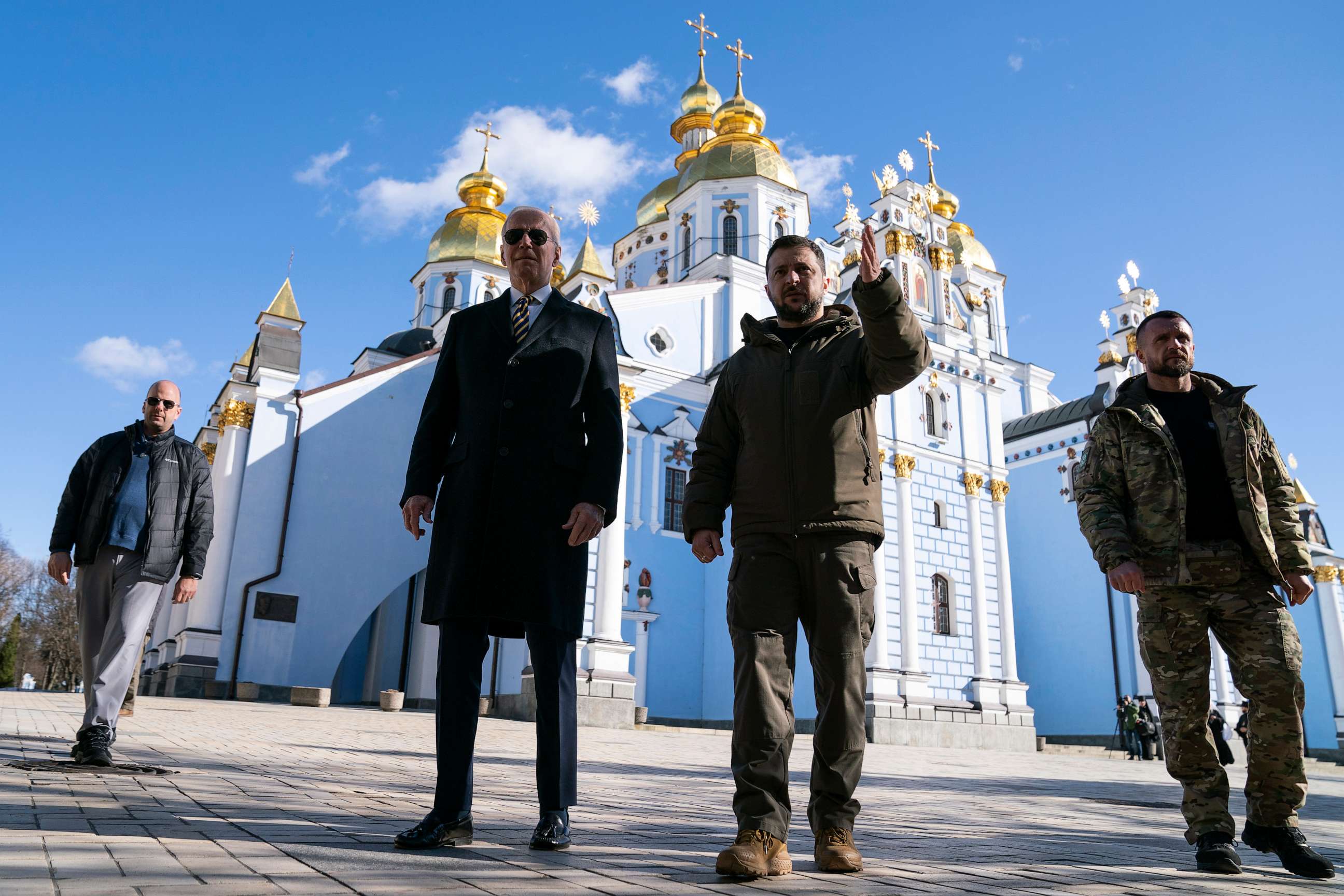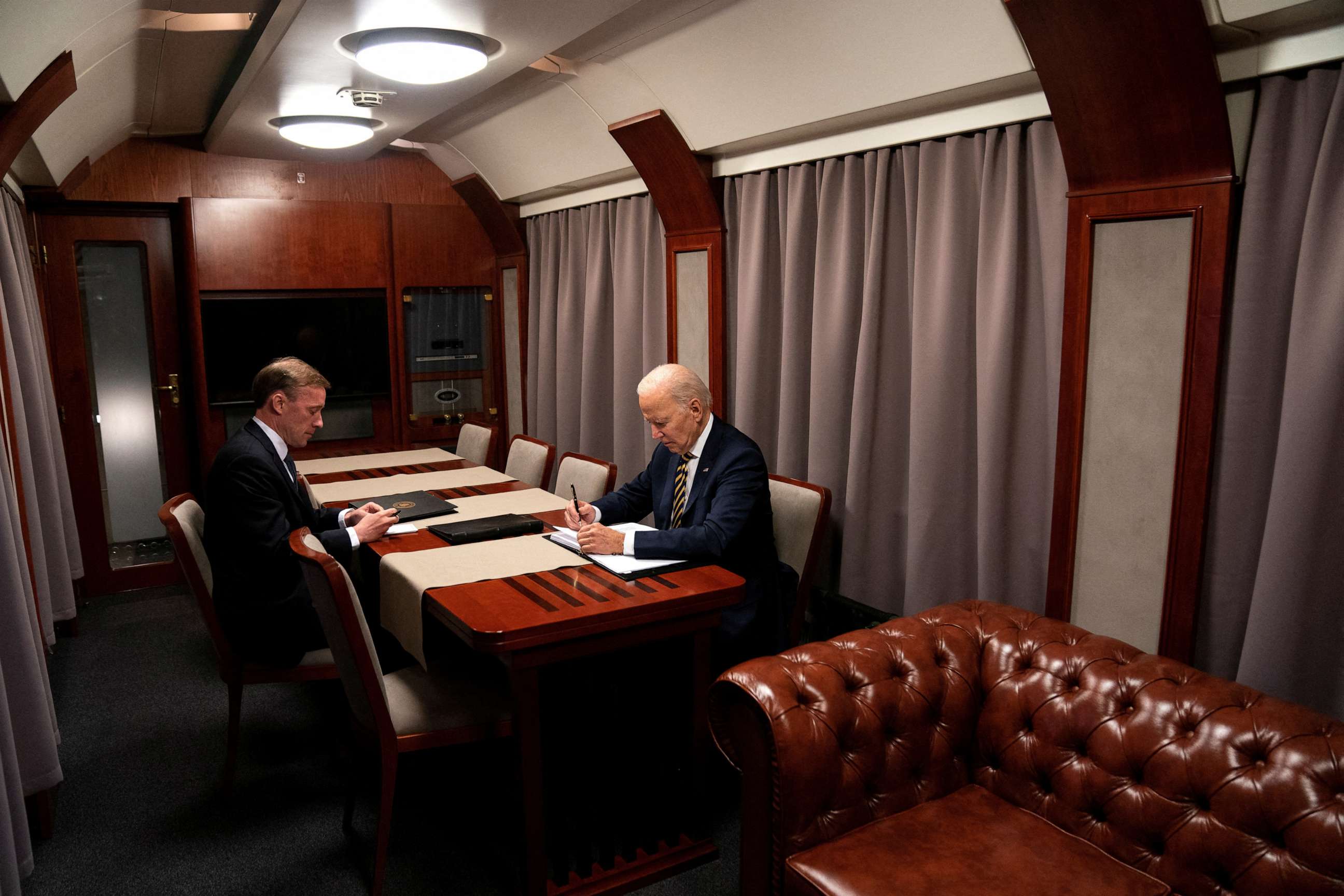US alerted Russia of Biden's surprise trip to Ukraine hours before he arrived, officials say
Planning for the visit was incredibly delicate and began months ago.
Following President Joe Biden's surprise visit to the Ukrainian capital of Kyiv on Monday, senior members of his administration detailed the security discussions that led up to the decision to go on the trip and the content of the meetings Biden had with Ukrainian President Volodymyr Zelenskyy over the course of his roughly five hours in the city.
And while the officials remained tight-lipped about the precise security details required to manage the trip, including Biden's mode of transportation in and out of the war-torn country, they did say that the U.S. informed Russia of the visit shortly before Biden left for Ukraine.
"We did notify the Russians that President Biden would be traveling to Kyiv. We did so some hours before his departure for deconfliction purposes," Jake Sullivan, the national security adviser to the president, told reporters on Monday morning in a press briefing.
"Because of the sensitive nature of those communications, I won't get into how they responded or what the precise nature of our message was. But I can confirm that we provided that notification," Sullivan said.
The planning for the trip was incredibly delicate, said John Finer, the U.S. deputy national security adviser, and began months prior.
"Only a handful of people" from offices across Washington were involved, including the White House chief of staff's office, the National Security Council, the White House Military Office, the Pentagon, the Secret Service and the intelligence community, Finer said.

"The president was fully briefed on each stage of the plan and any potential contingencies and then made the final go- or no-go decision after a huddle in the Oval Office and by phone with some key members of his national security cabinet on Friday," Finer said.
Among the challenges around such a visit was the limited U.S. military and embassy presence in Ukraine, compared to other war zones that presidents have visited, administration officials said.
"Unlike previous visits ... like Iraq and Afghanistan, the U.S. obviously does not have a military presence on the ground in Ukraine which made a visit from a sitting president all the more challenging. But this was a risk that Joe Biden wanted to take," White House communications director Kate Bedingfield said.
The administration officials emphasized that the risk was strategic -- intended to show Russian President Vladimir Putin that the U.S. stands strong with Ukraine and is confident enough in Ukraine's military prowess to visit the capital city in a time of war, one year after Russia first invaded.
"What he [Biden] wanted to do in Kyiv was to send a clear, unmistakable message of enduring American support for Ukraine," Sullivan said.
"And also to be able to stand there next to President Zelenskyy in a free Kyiv to not just tell, but to show the world through a powerful demonstration that Ukraine is successfully resisting Russian aggression and Russia is suffering strategic failure in Ukraine," Sullivan said.


Asked whether there were security concerns from the Pentagon or other officials, Sullivan declined to share the planning conversations but said that Biden made the decision based on presentations from his security team.
"The president proceeded with the confidence that his security team was able to bring risks to a manageable level," Sullivan said. "That was what ultimately led him to make the call to go."
"I am not going to get into specifics of who said what to him in the Oval, particularly on things as sensitive as his security. I will just say that he got a full presentation of a very good and very effective operational security plan. He heard that presentation. He was satisfied that the risk was manageable," Sullivan said.
While in Kyiv, Biden met with Zelenskyy and Ukrainian first lady Olena Zelenska at Mariinsky Palace, visited St. Michael's Golden-Domed Cathedral in central Kyiv and laid a wreath at the Wall of Remembrance for those slain in the Russia-Ukraine conflict, just as air raid sirens sounded.
Biden also announced another $500 million in aid, which he's expected to further detail in a speech on Tuesday night from Poland.

During the visit, which lasted from around 8 a.m. to 1 p.m. local time, Zelenskyy and Biden had an extended conversation about "all aspects of the ongoing war," according to Sullivan, including the battlefield, humanitarian aid, energy infrastructure and economic support.
Biden was also briefed by members of Zelenskyy's team to understand what would be needed to sustain Ukraine's efforts "and then some."
Regarding whether F-16 fighter jets were discussed -- which Zelenskyy has long sought -- Sullivan would not get into the specifics of the discussion, though Biden and Zelenskyy noted in their public remarks from Kyiv that the U.S. wasn't sending any new ammunition that Ukraine hasn't received before.
"What I will say is that there was a good discussion on the subject. I think the two presidents both laid out their perspectives on a number of different capabilities that have been thrown around in the press both recently and over the course of several months. And I will leave it at that," Sullivan said.

Behind-the scenes trip details released
Upon Biden's return to Poland, the pool reporter with the president shared some details of his secret journey from the White House to Europe.
Air Force One departed in the pre-dawn darkness on Sunday for Germany, where it refueled at Ramstein Air Base for a little over an hour.
From there, Biden flew to Rzeszów-Jasionka Airport in Poland before boarding a train for a 10-hour journey. Most of the train's eight cars were occupied by a heavy security presence before arriving in Kyiv around 8 a.m. local time.
After visiting with Zelenskyy, Biden took a similar train ride back to Poland, returning to NATO territory.
ABC News' Tal Axelrod contributed to this report.




